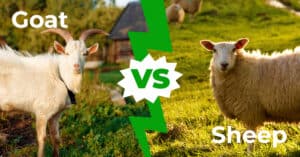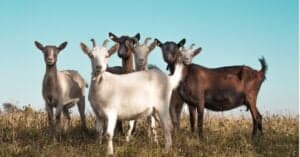Like them or hate them, goats are one of the most popular livestock animals. They’re generally regarded as farm animals and known for their rock-climbing abilities. Mountain goats, particularly, have been seen to travel almost 15 miles on rocks to lick natural salt deposits that contain vital nutrients.
But how about trees? At a glance, tree climbing isn’t a skill you associate with goats, right? Monkeys, koalas, tree kangaroos, baboons, and even bears usually come to mind. We’ll find out whether or not goats can climb trees in no time. Keep reading.
Species Profile: Goat
The goat (Capra hircus), one of the earliest domesticated animal species, is an antelope-goat species generally raised as a barnyard animal. It originated from the wild goat (Capra aegagrus) native to Southwest Asia and Eastern Europe.
The goat is a close relative of sheep because it belongs to the tribe Caprini and the animal family Bovidae. Over 200 distinct domestic goat breeds exist, each with a different use. Some are raised for fiber, others for dairy or meat.
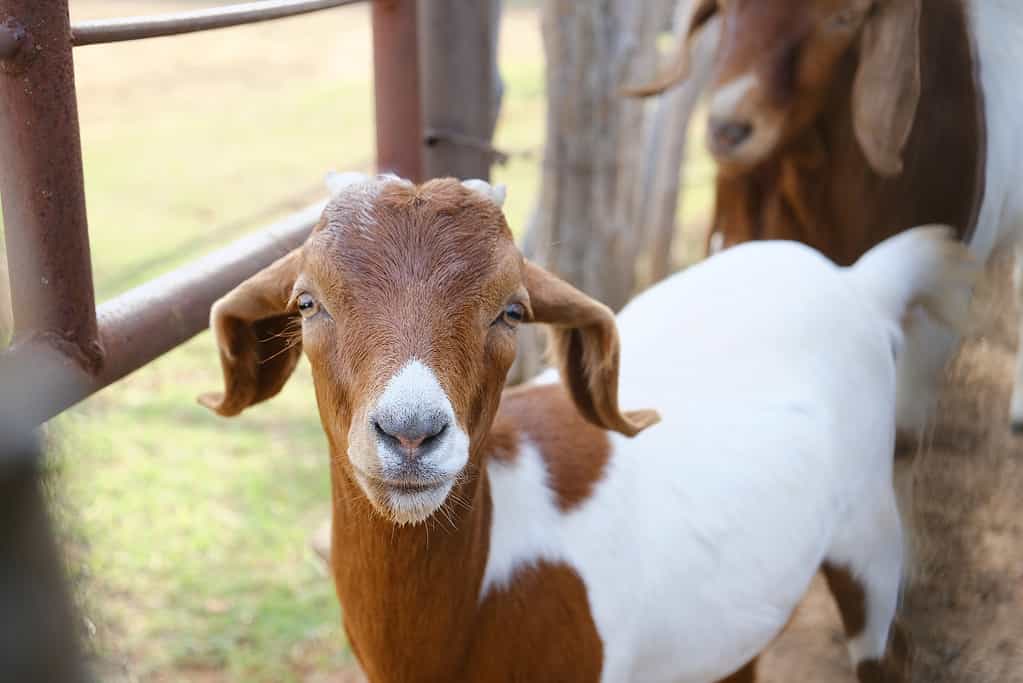
Goats are one of the most popular livestock animals.
©iStock.com/Candice Estep
Physical Characteristics and Appearance
Domestic goats have an extensive record of domestication, leading to various breeds and varying characteristics. Different species can range from 20 to 250 pounds in weight and 10 to 42 inches in height. The length range is from 45 to 67 inches.
Goats come in a variety of hues, including solid shades of white, brown, red, and black, a combination of these colors, tri-colored, spotted, or two-tone. Both sexes of goats can grow beards. Many of them, most notably dairy goats, dairy-cross Boers, and pygmy goats may also develop wattles, little hairs that hang from each side of the neck.
Yellow and brown eyes are the most prevalent, though other colors exist. Goats are renowned for having sharp vision even at night. However, they lack tear ducts; this makes them vulnerable to airborne particles like seeds or hay. They are also more likely to have less severe conditions like inverted eyelids.
Their hair, whether short or long, can be curly, smooth, or coarse. They have different-sized, erect, or drooping ears. Face stripes and black and white saddles are other possible physical features of goats.
Being ruminant animals, goats have a four-chambered stomach which includes the rumen, the reticulum, the omasum, and the abomasum, and are even-toed ungulates.
A goat’s digestive system produces digestive fluids and enzymes continuously throughout its adult life, unlike other animals whose digestive organs and secretions fluctuate in response to stress and times of inactivity.
Adaptations
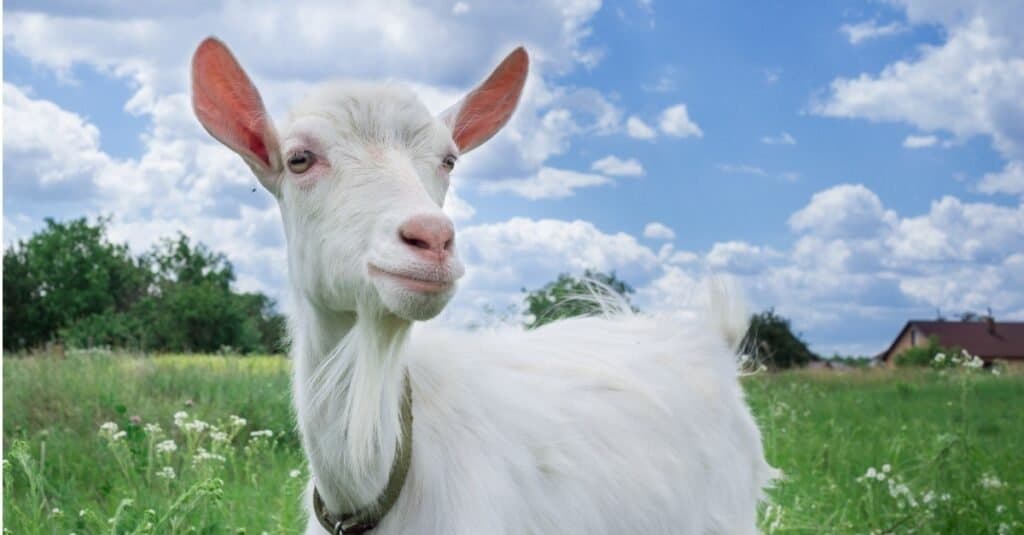
Goats love climbing on all sorts of things. This behavior allows them to show which ones are the dominant ones in the group.
©iStock.com/VeraOsco
Several studies have focused on their horizontal and rectangular pupils. However, according to UC Berkeley and Durham University researchers, the animal’s ecological niche is related to its pupil shape.
Typically, predators have vertical slit pupils to better gauge distance and attack their prey. On the other hand, herbivores, often predators’ primary prey, have rectangular slit pupils to protect themselves. As a result, they get a 360-degree view that makes identifying predators from different angles possible.
When they bow their heads, goats can rotate their eyes such that the slits are always parallel to the ground. In comparison to the human eye, they have a 10x greater range of rotation (more than 50 degrees per eye). Thus, they can closely check their surroundings and any prowling predators even while they are grazing. The senses of goats were fine-tuned in the years spent in the wild before domestication. As a result, they have adapted to fend off predators and navigate their natural environment in many ways, including competing for mates, protecting their young in arid, mountainous terrain, and foraging.
Goats’ keen sense of smell is crucial for social interactions, predator avoidance, and nutrition. They have much more sensors in their nostrils and on the wet skin of their noses than we do. Does first form a link with their babies by being familiar with their distinctive aroma.
Before grabbing food bites with their lips, they first sniff the item and then feel it with their sensitive lip whiskers. As curious animals, their lips are their primary grasping mechanism. They also have highly distinct rugae, or grooves, on their lips, which they use to hold and navigate thorny plants.
Reproduction
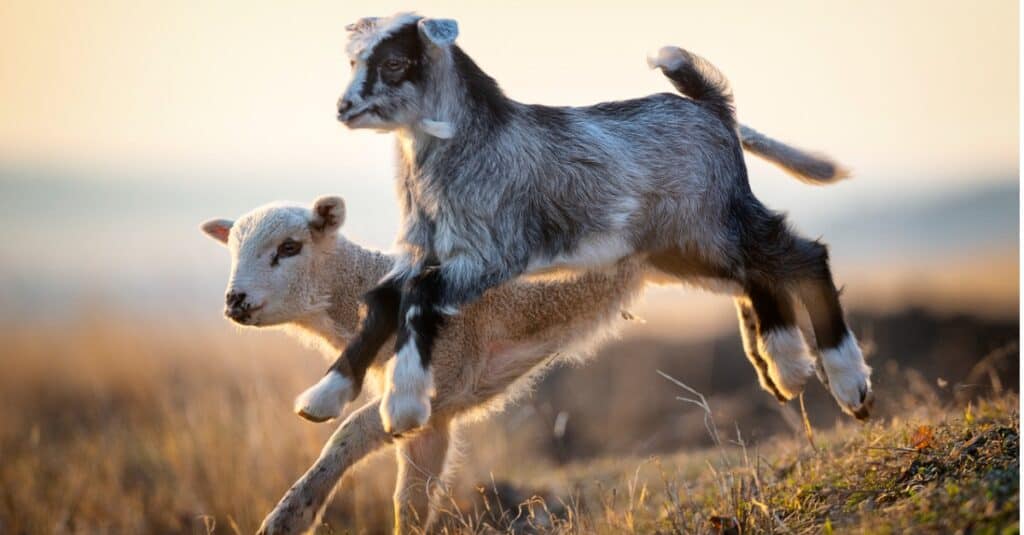
Goat kids develop early and can walk within hours of birth. In about 10 months, they are weaned and can graze.
©iStock.com/Tutye
Most goat breeds are born with two horns, which vary in size and shape. However, in a genetic oddity assumed to be inherited, there have been instances of goats with multiple horns — up to eight.
Though some goats are polled (born without horns), a consistent success rate has yet to be achieved with all goats, unlike cattle. The problem with polled goats is that the polled gene is very close to the sex-determining gene. Hence, the outcome of breeding two genetically polled goats together is a high proportion of usually sterile, intersex offspring.
Contrary to cattle with four teats, nannies only have two on their udders. The Boer goat, however, is peculiar. Sometimes, having up to eight teats.
Breeding takes place between late summer and early winter. It takes a nanny 18 days to reach her estrus cycle. However, some breeds in tropical regions can reproduce year-round.
Breeds vary in gestation length, ranging from 145 to 152 days. Regular brood size is one to three young, though twins are very common.
The kids develop early and can walk within hours after birth. Weaning and independent grazing occur about 10 months after. Males attain reproductive maturity around 5 months old, while females do so about a year old.
How Do Goats Behave?

Goats are natural climbers.
©iStock.com/Devon Swanson
Goats are curious, energetic, and intelligent animals.
Breed, environment, and herd size all affect a goat’s behavior. They tend to be gregarious, curious, perceptive, and energetic. They are infamous for trying fences and enclosures to see whether they can escape their confines, either on purpose or just because they are accustomed to climbing.
You have to reconsider your stance if you didn’t think goats were intelligent. They easily pick up positive and undesirable habits, including unlocking gate latches.
According to a 2019 study published in Frontiers in Zoology, goats can tell whether other goats are happy or unhappy simply by listening to their voices. This proven emotional intelligence places them on the list of non-human animals that can sense the emotions of their relatives, such as horses, monkeys, and sheep.
Goats are pretty tactile, and even as adults, they still like being gently stroked and scratched by other goats or people. They’re also renowned for maintaining balance in hazardous situations.
Where Do Goats Live?

Domestic goats are housed in sturdy pens or barns.
©Georgia Evans/Shutterstock.com
Goats are seen in mountainous areas in the wild in Asia and some parts of Africa and Europe. Their preferred climates are arid and hot. Thus, most goats are commonly found in the tropics and equatorial regions. Some goats do, however, survive the chilly temperatures of Europe.
Domestic goats are housed in sturdy pens or barns.
How Many Kinds of Goats Are There?

The United States has four main types of goats but there are many other different lesser known types.
©AjazKh/Shutterstock.com
According to the United States Department of Agriculture (USDA), the country has four main types of goats. First, there are predominantly milk-producing dairy goats such as the Alpine goat, the South African native Boer goat species, which can reproduce while nursing its kids and adapt to many temperatures; the Turkish Angora goat bred for its mohair, and Spanish brush goat raised for meat and brush clearing.
Other popular goat breeds in the United States include LaMancha, Nigerian dwarf, pygmy, Savanna, Toggenburg, myotonic, Nubian, Saanen, Sable, and Obhersali.
What Do Goats Eat?
Goats are excellent browsers; they enjoy raising their heads to consume nearby vegetation. Their curiosity leads to sample things before deciding whether or not they’re edible. In actuality, goats are picky eaters. They prefer to nibble on woody plants, aromatic herbs, briars, shrubs, weeds, and forbs.
They have a higher nutritional requirement than larger ruminants. Still, they are prized for thriving on readily available, inexpensive food sources compared to other livestock.
Can Goats Climb Trees?
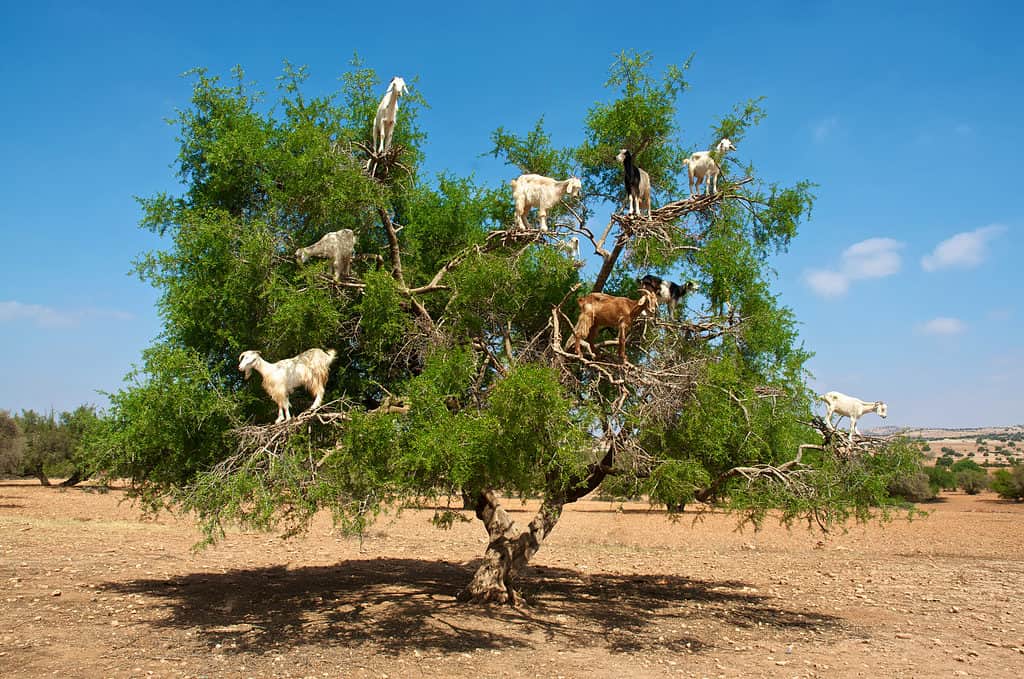
Moroccan goats are well known for their tree-climbing skills.
©iStock.com/aerostato
Goats can climb trees, something they may do to feed on the remaining available foliage leaves.
Yes, goats can climb trees. As highly agile animals, goats don’t hesitate to climb trees to consume the possibly sole source of greenery, especially in dry areas with little to no fodder. At other times, they climb trees to get more food after eating all the fallen fruits on the ground.
The internet-famous Moroccan tree-climbing goats may come to mind. Domestic goats, typically owned by local farmers in southwestern Morocco, broke the internet when pictures of them perched on tree branches emerged. This has attracted tourists to the region, particularly during summer and fall.
The generous host trees are known as argan or Moroccan ironwood. The evergreen trees are quite uncommon, primarily found in the semi-arid areas in southwestern Morocco, and it takes a lot of effort to reach the top. For context, the trees can grow as high as 33 feet.
With a lifespan of up to 450 years, these trees are resilient and remarkably drought-tolerant. They are vital to the local economy and ecology since they provide the residents with food and fuel and argan oil, a viable export product to the West, where it’s used in cosmetic products.
The land is shielded from erosion and the expanding Sahara Desert because of how deeply the roots of these trees delve in quest of water.
What attracts goats to argan trees? The pleasant-smelling but bitter-tasting fruits on the trees that ripen between June and July every year. Each fruit contains one-three small, oil-rich seeds encased in a hard shell.
The argan tree is native to a semidesert region with an annual rainfall of about 12 inches. When autumn rolls around, the goats will have eaten all the edible vegetation on the ground. As a result, they climb the trees to feed on the remaining available foliage leaves.
How Do Tree-climbing Goats Help to Disperse Seeds?
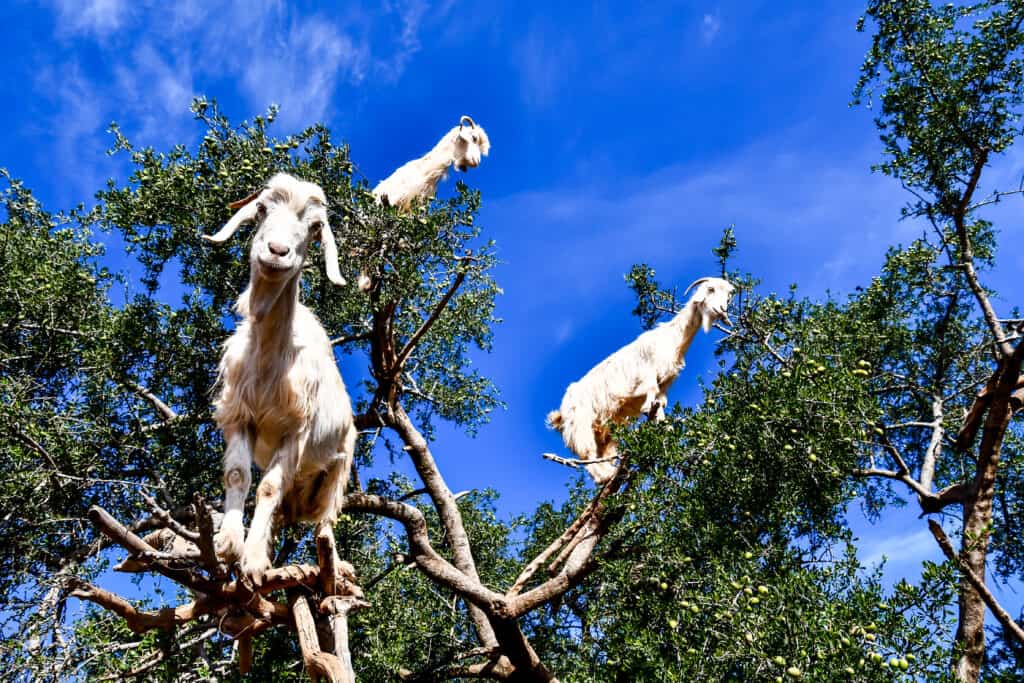
Since goats are ruminants, researchers hypothesized that they likely spit the nuts out while chewing their cud.
©underworld/Shutterstock.com
The popular claim that goats defecate the nuts after eating argan fruits prompted a study to test the viability. The researchers concluded that argan nuts are too big to move down the goats’ digestive system. Since goats are ruminants, the researchers hypothesized that they likely spit the nuts out while chewing their cud.
They supported this assertion with the outcome of research in Spain which showed that goats spat nuts when fed with olive and dwarf palms. Then, they conducted further studies using domestic goats fed the fruits of six different plants with varying seed sizes and shapes. This was to ascertain whether the seeds were spat or excreted and test the viability of the ejected seeds. The result showed that over 70% of the regurgitated seeds still had growth potential. Thus, spitting goats may be an undervalued ecological contributor to seed dispersal.
Like other ruminants, goats re-chew their meal after it has fermented in the rumen. This distinct stomach serves as a live fermentation chamber. The plant can ensure dispersal and reduce the possibility of losing its seeds by being spat in the rumination process.
Are Goats Endangered?
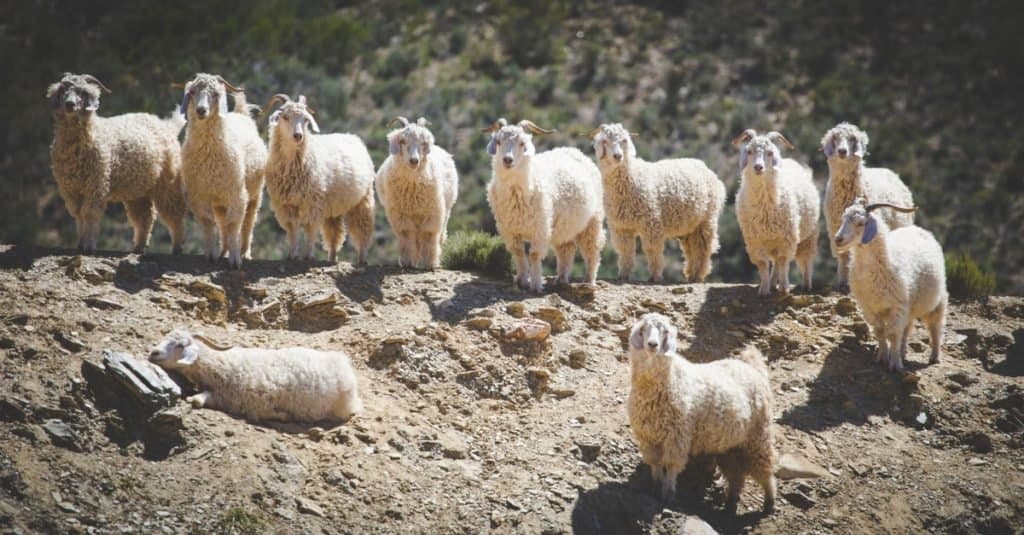
While domestic goats may not be endangered, the IUCN Red List has the wild goat classed as Near Threatened.
©Dewald Kirsten/Shutterstock.com
There are a lot of domestic goats, and they are not particularly endangered. The IUCN Red List, however, has the wild goat classed as Near Threatened. This is because habitat loss and degradation pose a threat to this species.
The photo featured at the top of this post is © underworld/Shutterstock.com
Thank you for reading! Have some feedback for us? Contact the AZ Animals editorial team.




